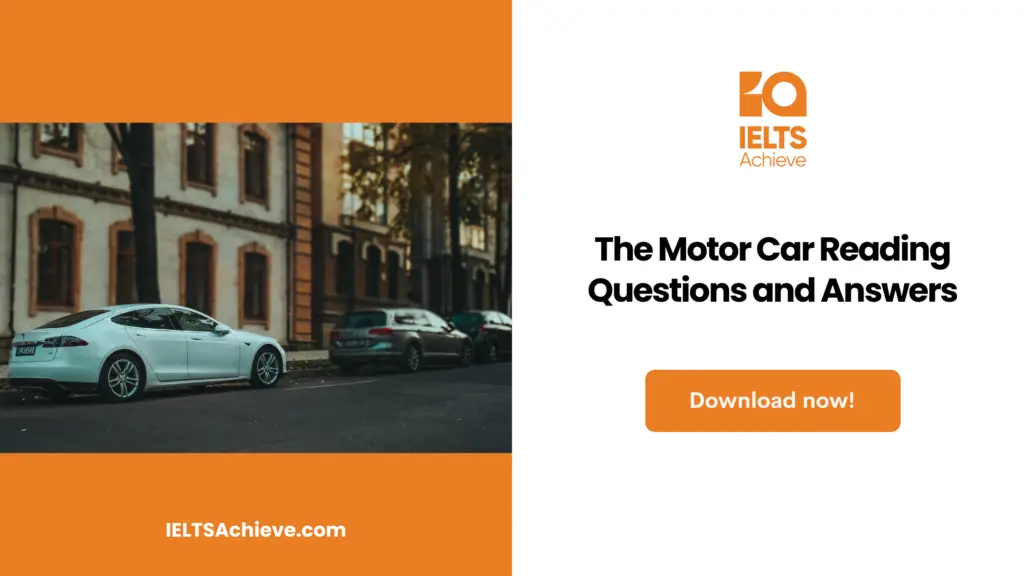The Blog post contains the following IELTS Reading Questions:
- IELTS Reading Locating Information
- IELTS Reading Yes/No/Not given
- IELTS Reading Short answer questions
Stay informed and prepared for success – Explore our comprehensive Reading Test Info page to get valuable insights, exam format details, and expert tips for mastering the IELTS Reading section.
IELTS reading passage – The Motor Car

The Motor Car
With the number increasing at a rate of about 40 million per year, there are currently over 700 million automobiles on the road worldwide. The average distance travelled by car users is increasing rapidly in Western Europe, from 8 km per person per day in 1965 to 25 km per day in 1995. This reliance on cars has led to big problems like pollution, running out of oil, traffic jams, and safety.
New vehicle emissions are substantially less harmful than they were previously, but metropolitan streets and highways are becoming more congested with people than ever, with many older trucks, buses, and taxis spewing excessive amounts of smoke and fumes. Because of the high number of automobiles in urban areas, the air quality is sometimes unpleasant and even hazardous to breathe. Even Moscow has joined the list of capital cities suffering from traffic congestion and pollution. Vehicle pollution is a major health concern in Mexico City.
Prior to a hundred years ago, most excursions were limited to a distance of 20 kilometres, which was conveniently traversable by horse. Heavy cargo could only be transported by water or rail. The introduction of the automobile provided personal mobility to the masses while also facilitating freight distribution over a far broader area. In the United Kingdom, approximately 90% of inland freight is now transported by road. The world cannot, obviously, return to horse-drawn carriages. Is it possible to move people and things without relying on congested and polluting modes of transportation?
The majority of European cities are still designed for antiquated modes of transportation. Adapting to the motor car has necessitated the addition of ring roads, a one-way network system, and parking lots. The land allocated to automobiles is considerably more than houses in the United States. Due to urban development, life without a vehicle is nearly impossible. Moreover, many people have been killed or injured due to the widespread use of motors. Other societal repercussions attributed to the automobile include alienation and aggressive human behaviour.
According to a 1993 study by the European Federation for Transport and Environment, car transportation is seven times more expensive than rail travel in terms of external social costs such as congestion, accidents, pollution, loss of farmland and natural habitats, depletion of energy resources, and so on. Vehicles readily outperform trains and buses as a flexible and convenient mode of personal transportation. It is unrealistic to expect people to give up their cars and rely solely on public transportation.
Emissions can be reduced as well as the fuel efficiency of engines can be improved with the use of technical solutions. However, fuel consumption and exhaust emissions are contingent on client preference and driving style. Many individuals choose cars that are too large for their daily needs or squander fuel by driving recklessly. In addition, the worldwide car population is expanding at a faster rate than the reduction in pollutants and improvement in fuel economy that modern technology makes possible.
One proposed solution is the long-term option of constructing cities and neighbourhoods that minimise the need for car travel by placing all needed services within walking distance or within easy reach of public transportation. This would not only save energy and cut carbon dioxide emissions, but it would also improve the quality of community life by placing a greater emphasis on people rather than automobiles. This is already a reality in some locations due to the presence of competent municipal governments. Few democratic societies, on the other hand, have the foresight and financial resources to implement such significant changes in the way people live.
A combination of mass transportation systems for travel into and around cities, small “low emission” autos for urban use, and bigger hybrid or lean-burn automobiles for use elsewhere is the most likely scenario. To ensure that drivers pay fees commensurate to their actual road usage, electronic toll roads can be employed. Better transportation system integration is also very desirable, and modern computers have made this possible. These are, however, remedies for countries with the financial means to implement them. In most developing countries, people still drive old cars and use old technology.
Unlock your full potential in the IELTS Reading section – Visit our IELTS Reading Practice Question Answer page now!
Recommended Questions:
Renewable Energy IELTS Reading Question with Answer
The Motor Car reading questions
Questions 1 – 6
Reading Passage 2 has eight paragraphs (A-H). Which paragraphs concentrate on the following information? Write the appropriate letters (A-H) in boxes 1-6 on your answer sheet. NB You need only write ONE letter for each answer.
1. a comparison of past and present transportation methods
2. how driving habits contribute to road problems
3. the relative merits of cars and public transport
4. the writer’s own prediction of future solutions
5. the increasing use of motor vehicles
6. the impact of the car on city development
Questions 7 – 11
Do the following statements agree with the information given in Reading Passage 2? In boxes 7-11 on your answer sheet write
YES if the statement agrees with the information
NO, if the statement contradicts the information
NOT GIVEN if there is no information on this in passage
6. Vehicle pollution is worse in European cities than anywhere else.
7. Transport by horse would be a useful alternative to motor vehicles.
8. Most European cities were not designed for motor vehicles.
9. Redesigning cities would be a short-term solution.
Want to excel in identifying the writer’s views and claims? Click here to explore our in-depth guide on how to accurately determine Yes, No, or Not Given in the IELTS Reading section.
Questions 12 – 14
Answer the questions below.
Write NO MORE THAN THREE WORDS AND/ OR A NUMBER from the passage for each answer.
12. In terms of external societal costs, how many times more expensive was automobile travel than rail travel?
13. Which mode of transportation was employed to convey large freight one hundred years ago?
14. How much inland freight was transported by road in the United Kingdom?
Unlock your full potential in the IELTS Reading section – Visit our IELTS Reading Practice Question Answer page now!
Recommended Questions:
Renewable Energy IELTS Reading Question with Answer
The Motor Car reading answers
1. Answer: C
2. Answer: F
3. Answer: E
4. Answer: H
5. Answer: A
6. Answer: D
7. Answer: Not Given
8. Answer: No
9. Answer: Yes
10. Answer: No
11. Answer: Seven or 7
12. Answer: Water or rail
13. Answer: 90% or percentage

We hope you found this post useful in helping you to study for the IELTS Test. If you have any questions please let us know in the comments below or on the Facebook page.
The best way to keep up to date with posts like this is to like us on Facebook, then follow us on Instagram and Pinterest. If you need help preparing for the IELTS Test, join the IELTS Achieve Academy and see how we can assist you to achieve your desired band score. We offer an essay correction service, mock exams and online courses.

